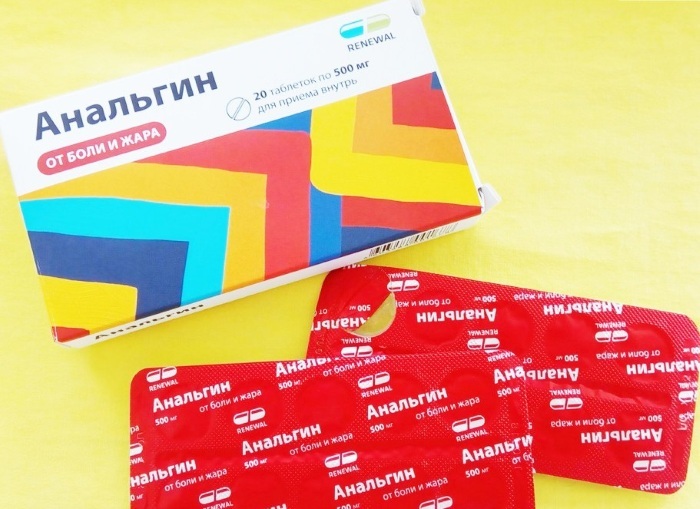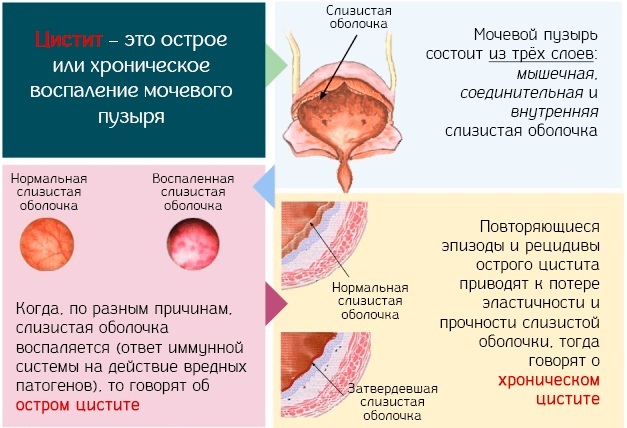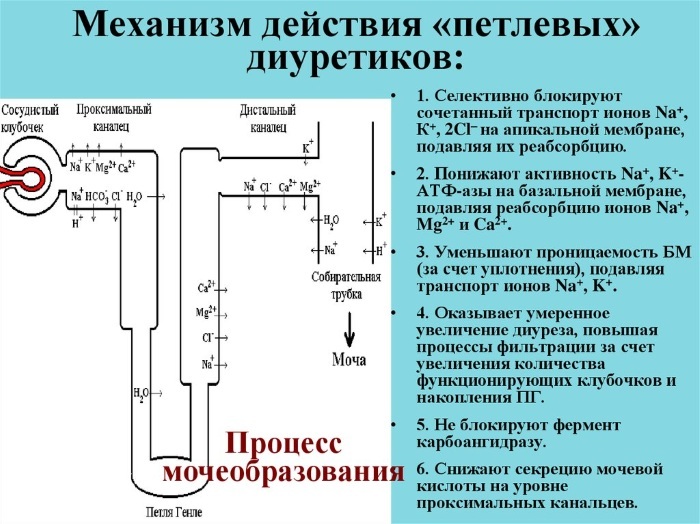The drug Rutozida trihydrate is a semisynthetic drug with a wide spectrum of action. This is a medication used to treat thrombophlebitis, varicose veins, and other vascular diseases.
Record content:
- 1 Chemical composition of Rutoside trihydrate
- 2 Properties
- 3 pharmachologic effect
- 4 Pharmacodynamics and pharmacokinetics
- 5 Release form
- 6 Indications for use
- 7 Contraindications
- 8 Side effect
- 9 special instructions
- 10 Rutoside during pregnancy and lactation
- 11 Instructions for use of Rutoside trihydrate
- 12 A course of treatment
- 13 Overdose
- 14 Interaction with other medications
- 15 The country of manufacture
- 16 Terms of sale
- 17 Rutin and other analogues
- 18 Price
- 19 Video about Routine
Chemical composition of Rutoside trihydrate
The pharmacologically active substance is synthesized from natural plant materials. Rutozide trihydrate is a monopreparation that is similar in pharmacological properties and biochemical action to vitamin P.
It is an organic compound obtained using extraction technology. The result of chemical synthesis is a substance of a complex molecular structure called quercetin 3-rutinoside.
The resulting compound is a yellow-orange crystalline powder. It is slightly soluble in monohydric alcohols and boiling water. The substance does not accumulate in the tissues of the body, but quickly decomposes into carbon and aromatic oxides.
Rutoside trihydrate is the trade name for quercetin. Citrus peel is saturated with a vegetable analogue of vitamin P. For the first time, chemists have isolated the glycoside of the flavonoid quercetin from lemon.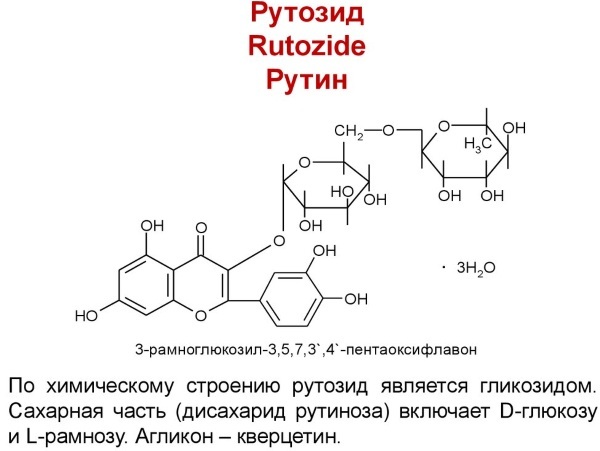
Later he was found in:
- mint;
- raspberries;
- blueberries;
- apricot;
- grapes, some other berries and fruits.
This glycoside of the flavonoid category is used not only in pharmacology, but also in the food industry.
Properties
Rutoside trihydrate neutralizes the action of free radicals, prevents cell destruction, and reduces the effect of carcinogens. It has all the typical properties of a flavonoid.
The substance slows down the development of inflammatory processes and fills the female body with chemical compounds similar in molecular structure and physiological action to sex hormones estrogens.
Rutoside has a positive effect on the venous walls, making them elastic, strong and permeable. It prevents the formation of cholesterol deposits. Glycoside flavonoid reduces the risk of cardiovascular pathologies and is effective in the complex treatment of varicose veins.
The substance has antioxidant properties and antihistamine effect, due to which it suppresses allergic reactions. Rutozide trihydrate stops the progression of tumor neoplasms and stimulates cell division, rejuvenating body tissues.
pharmachologic effect
The drug has an angioprotective effect, strengthening the walls of blood vessels and giving them natural elasticity. Under the influence of Rutozid trihydrate, tissue edema decreases and the development of inflammatory processes of infectious origin is suspended. The medication slows down the aggregation of red blood cells, improving the rheological parameters of the blood.
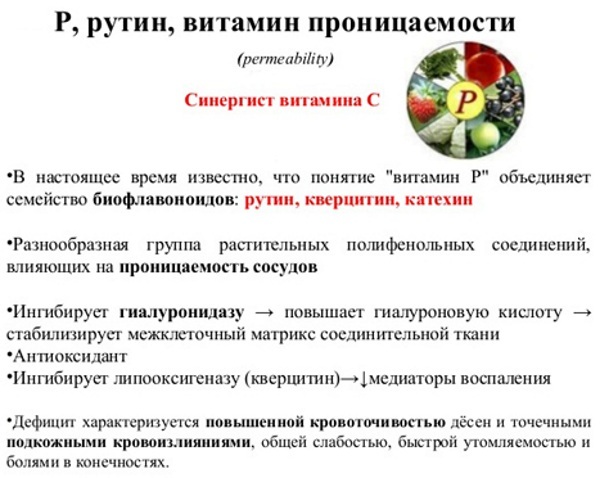
The pharmacological action of a semi-synthetic flavonoid is based on its ability to strengthen small capillaries and large arteries, and to increase the conductivity of nerve impulses.
In the treatment of venous dystrophy of various etiologies, the biochemically active component of the drug:
- relieves pain syndrome;
- improves the condition of the skin;
- normalizes blood microcirculation in the surface and deep layers of the epidermis;
- eliminates lymphatic disorders provoked by radiation therapy.
Rutozide trihydrate is a semi-synthetic analogue of vitamin P, which improves vascular permeability and blood flow in pathologically altered veins.
Pharmacodynamics and pharmacokinetics
The active substance of the drug is similar in chemical structure to ascorbic acid and is capable of entering into a stable relationship with it. Rutozide trihydrate prevents the rapid breakdown of vitamin C and improves its absorption by the body.
Pharmacodynamic characteristics of the drug are based on the ability of the active substance to bind free radicals that accelerate the aging process of cells and introduce pathological structural changes.
Additionally, the semi-synthetic glycoside increases the immune status and improves the outflow of lymphatic secretions. The limiting concentration of the active component in the blood plasma is reached after 9 hours. after oral administration of the drug. The half-life is 10-25 hours, depending on the intensity of natural metabolic processes.
Trihydrate is removed from the body of Rutozid in the form of pharmacologically inactive metabolites. Excretion methods are bile acid and deurination. The drug is predominantly metabolized in the liver, to a lesser extent in the kidneys. The bioavailability of the active substance is 93%.
Release form
The drug is used to treat a wide range of vascular pathologies.
It is produced in 5 dosage forms for external and internal use:
- In tablets with a semisynthetic flavonoid content of 20, 50, 500 mg;
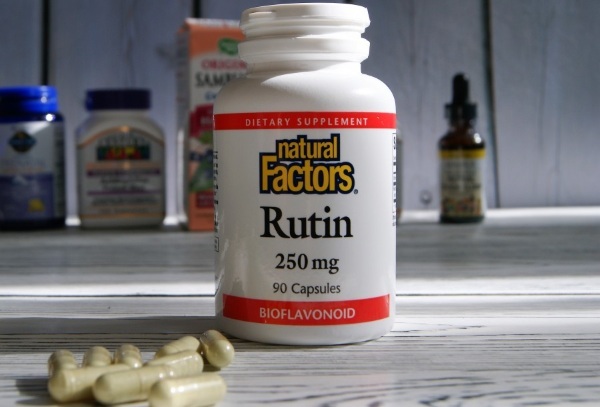
- In capsules in a water-soluble gelatinous shell. Inside them, Rutozide trihydrate is contained in the form of a greenish-yellow substance.
- In the form of a powdery medicine for dilution with water;
- In the form of an injection solution in ampoules with a capacity of 1 ml.
- In ointments and gels for the treatment of varicose veins and cooling the inflamed skin in case of allergic reactions.
Rutozid trihydrate injectable solution carries the trade name Urutin. Ointments and cooling gels for external use eliminate trophic disorders and other destructive changes in the structure of the epidermis.
A variety of release forms and dosages of the active substance allows you to choose a medication in accordance with the type and nature of the pathological process. Many vascular and venous diseases need to be treated in a complex way - by a combination of external agents with drugs for internal administration.
Indications for use
Semisynthetic flavonoid has a wide range of pharmacological actions. It is prescribed for the treatment of a huge number of vascular and skin pathologies, for the elimination of anaphylactic manifestations in children and adults.
The main indications for the use of Rutozid trihydrate:
| Disease | Description and characteristics |
| Atherosclerotic retinopathy | Destructive changes in retinal vessels associated with dystrophy and impaired blood circulation in the fundus. |
| Retinal dystrophy in patients with diabetes mellitus | Damage and death of retinal capillaries due to impaired transport of oxygen and nutrients. Such a pathological condition is provoked by an excess content of glucose in the blood. |
| Inflammation of the subcutaneous veins | Pathology resulting from changes in the rheological properties of blood and dystrophic transformation of the vascular walls. |
| Deep thrombophlebitis | A pathological condition characterized by blockage of deep-lying bloodstreams.
|
| Disseminated varicose veins | Deformation of the venous walls caused by the penetration of infectious pathogens or the formation of tumor cells. |
| Lymphostasis | Pathological accumulation of secretion enriched in protein compounds in the interstitial (intercellular) cavity, accompanied by a violation of the movement of lymphatic fluid and the proliferation of the affected organ. |
| Lipedema | Chronic pathology characterized by the accumulation of subcutaneous fat. |
Rutozide trihydrate is used to treat all types of rhinopathies - diabetic, atherosclerotic, hypertensive. This drug is used not only for the treatment of venous pathologies.
It is prescribed for hemorrhoids, to relieve post-traumatic edema and relieve pain. The drug is effective for skin allergies and trophic ulcers. A semi-synthetic flavonoid is used for vitamin deficiency due to its ability to intensify the transport of nutrients.
Contraindications
Vitamin P analogue has minimal toxicity and plant origin. The main clinical limitation on the use of the drug is the increased sensitivity of the body to the pharmacologically active component of the drug.
A semi-synthetic flavonoid is not prescribed for:
- kidney failure;

- chronic liver disease;
- inflammation of the urinary system;
- violations of the outflow of bile secretion;
- a large amount of stony deposits in the bladder.
With extreme caution, you need to take medication for pathologies of the heart muscle and the entire organ as a whole.
Side effect
Negative effects are few in number and are mainly associated with individual intolerance to the active substance of the drug. Dyspeptic manifestations and an unpleasant sensation in the abdominal cavity are possible.
After taking Rutozide trihydrate, some patients experienced mild headache, nausea, and allergies. Severe migraines are extremely rare and go away within 1 hour. after taking the medicine.
The appearance of an allergic rash without itching is possible. For topical formulations, irritation of the epidermis is characteristic in patients with hypersensitive skin.
special instructions
The drug does not affect the reaction rate, the ability to drive vehicles and hazardous industrial machinery. It does not change the degree of nervous excitability.
Within 1 hour after taking the drug, it is advisable to avoid high-altitude work due to the possibility of side effects in the form of nausea and dizziness. During the course of treatment, it is important to stop drinking alcoholic beverages and tobacco products.
Rutoside during pregnancy and lactation
Semi-synthetic flavonoid of plant origin is approved for use in the II and III trimesters pregnancy only after prior consultation with a doctor. Studies on the ability of the drug to pass into breast milk have not been conducted.
The degree of teratogenic effect has not been established. The drug is not prescribed in the first trimester of pregnancy. During lactation, it is better to refuse to take the drug. Oversaturation with synthetic vitamin P is theoretically capable of causing disturbances in intrauterine development and pathology of the child's circulatory system.
Instructions for use of Rutoside trihydrate
The drug is rarely used for monotherapy of venous pathologies, since in this case it has low clinical efficacy. The relevance of the use of Rutozide trihydrate as the only drug is observed only with a deficiency of vitamin P.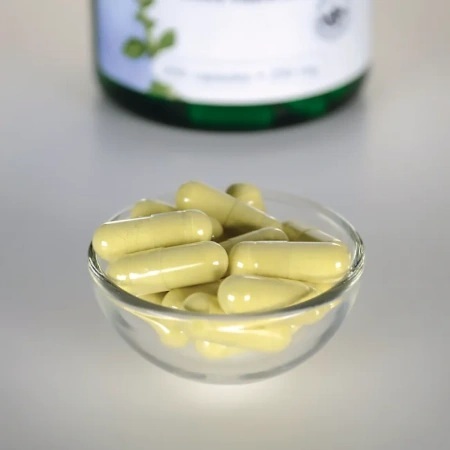
The therapeutic scheme is determined by the form of release of the drug, the age of the patient and the nature of the pathological process.
The recommended dosage does not depend on the severity and degree of venous deformity.
The standard treatment regimen for adults is to take 1 tablet 3 times a day.
Gel and ointment for external use is applied to the affected area of the skin with a thin layer twice a day. Capsules are taken 3 times a day, 1 pc.
For children, the maximum daily allowance is 20-25 mg of a plant flavonoid. Teenagers can consume up to 30 mg of the drug. For women, the maximum concentration of the active substance in the body should not exceed 75 mg in the treatment of varicose veins.
Rutozide trihydrate is a drug that is effective in relieving anaphylactic pathology. In this case, the reception pattern is changed. With severe symptoms, loading doses of 1000 mg per day are prescribed for 3 days.
Tablets and capsules in a gelatinous shell are taken orally with meals. After the disappearance of pathological symptoms, the dose is gradually reduced. Products for external use should be applied to previously cleansed and dry skin, rubbing in slowly without strong pressure.
Solution for injection is administered intramuscularly. The limiting daily concentration of the active component in the body of an adult varies within the range of 100-150 mg. Usually it is divided into 2-3 doses of 1 ampoule.
A course of treatment
The duration of therapy ranges from 14 days to 4 months. It depends on the type of pathology. The longest treatment is for trophic ulcers and venous insufficiency. In these cases, Rutozid trihydrate is prescribed as part of complex therapy.
Treatment cannot be interrupted suddenly. After suppression of symptoms, the dose is gradually reduced over 2 weeks. In the treatment of hemorrhoids, the therapeutic course is approximately 10 days. The doctor individually prescribes the daily rate, systematicity and duration of the drug intake.
Overdose
The vitamin flavonoid is well tolerated by most patients. With a systematic excess of the recommended daily allowance, typical signs of drug intoxication are not found.
The oversaturation of the body with semi-synthetic vitamin P rarely manifests itself:
- heartburn;

- slight discomfort in the epigastric region;
- nausea and other characteristic dyspeptic effects;
- redness of the skin of the face, which is caused by increased microcirculation of blood in the upper layers of the epidermis;
- minor migraines.
Such negative reactions of the body spontaneously disappear after lowering the dosage. Symptomatic therapy is not required. Adjusting the dose in accordance with the doctor's prescription and taking the medication with meals will avoid unpleasant phenomena.
Rutozide trihydrate is a drug that is unable to cause pathological dysfunctions internal organs, even with a significant excess of the maximum daily concentration of the active substances. If a headache occurs after taking the drug, you can drink an analgesic to relieve it.
Termination of therapy with the replacement of the drug with an analogue is advisable only in case of acute allergic reactions to a plant flavonoid. If signs of upset stomach occur, it makes sense to take activated charcoal or other absorbent, and also consult a doctor to adjust the dose downward.
Interaction with other medications
The semi-synthetic analogue of vitamin P is biochemical inert. It does not form a bond with other pharmacologically active substances and does not react with them. Rutozide trihydrate is compatible with any medications.
Its effect is enhanced by the combination with ascorbic acid and other preparations containing vitamins. Such a complex treatment accelerates the restoration of pathologically altered blood vessels and reduces the degree of deformation of the veins with varicose veins.
Rutozide trihydrate has a pronounced antioxidant effect and is well combined with other drugs of a similar purpose. When taken together, it is necessary to take into account the maximum daily dosage of both substances so as not to provoke the development of allergic reactions and various side effects.
The country of manufacture
A semi-synthetic flavonoid of plant origin is produced in Ukraine at the Borshchahiv pharmaceutical plant. Its main production and storage facilities are located in Kiev.
Terms of sale
No prescription is required to purchase the drug. Rutozide trihydrate is freely sold in any pharmacy in Ukraine and Russia.
Rutin and other analogues
An extensive group of medicines has an identical principle of biochemical action. The absolute analogue of Russian production is Rutin. The only difference is dosage forms.
Rutozide trihydrate is available in various versions, making it a versatile medicine. Russian Rutin is produced only in the form of a crystalline powder. Both drugs saturate the body with semi-synthetic vitamin P and are used for the same therapeutic purposes.
Another available analogue is Askorutin. In it, Rutin is combined into a single pharmacological complex with ascorbic acid. The medicine is available in tablets with a concentration of active ingredients of 50 mg.
The medication significantly improves the patient's condition with:
- thrombophlebitis;
- infectious infections;
- avitaminosis;
- hemorrhagic pathology;
- venous insufficiency.
The chemical formula of Venoruton is modeled on the basis of Rutin. It has a similar list of indications for use with a Ukrainian-made semi-synthetic flavonoid. This medication is available as a gel, oral tablet, and gelatin capsule.
A good clinical effect is provided by the use of Troxevasin, a drug based on Rutin. It has a beneficial effect on the condition of small capillaries and large arteries, has a tonic effect on the vascular network and suppresses inflammation of the bloodstream.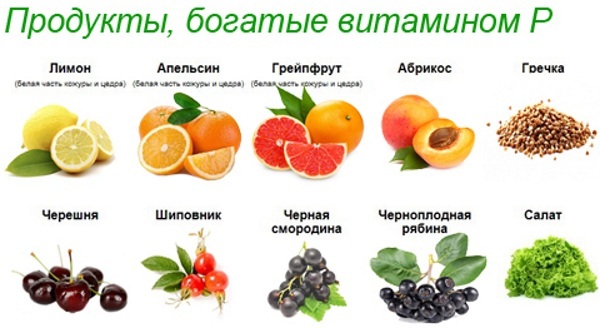
The Belarusian analogue of Rutozide trihydrate is called Troxerutin. All drugs have identical pharmacological action. They share the same set of indications, clinical restrictions on use, and side effects. They are taken according to a similar therapeutic regimen.
Price
Rutozida trihydrate costs in Russian pharmacies within 1000 rubles. for a pack of tablets of 50 pcs. In Ukraine, the price reaches 500 UAH. It is a relatively expensive vitamin. A pack of Venoruton in Russia costs 350-400 rubles, and Troxevasin costs 476 rubles. The cheapest analogue is Belarusian Troxerutin. It costs only 40-50 rubles in the form of a gel.
Video about Routine
Secrets of the flavonoid Rutin:

